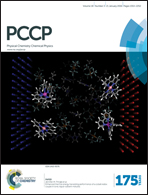First-principles anharmonic quantum calculations for peptide spectroscopy: VSCF calculations and comparison with experiments†
Abstract
First-principles quantum calculations for anharmonic vibrational spectroscopy of three protected dipeptides are carried out and compared with experimental data. Using hybrid HF/MP2 potentials, the Vibrational Self-Consistent Field with Second-Order Perturbation Correction (VSCF-PT2) algorithm is used to compute the spectra without any ad hoc scaling or fitting. All of the vibrational modes (135 for the largest system) are treated quantum mechanically and anharmonically using full pair-wise coupling potentials to represent the interaction between different modes. In the hybrid potential scheme the MP2 method is used for the harmonic part of the potential and a modified HF method is used for the anharmonic part. The overall agreement between computed spectra and experiment is very good and reveals different signatures for different conformers. This study shows that first-principles spectroscopic calculations of good accuracy are possible for dipeptides hence it opens possibilities for determination of dipeptide conformer structures by comparison of spectroscopic calculations with experiment.


 Please wait while we load your content...
Please wait while we load your content...